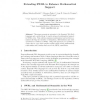RULEML
2010
Springer
14 years 2 months ago
2010
Springer
Rule bases are common in many business rule applications, clinical decision support programs, and other types of intelligent systems. As the size of the rule bases grows and the in...
RR
2010
Springer
14 years 2 months ago
2010
Springer
The sparse application of the Semantic Web Rule Language is partly caused by a lack of intuitive rule editors. This applies both from a human user’s, as well as from a software i...
ENTCS
2006
14 years 4 months ago
2006
An unresolved issue in SWRL (the Semantic Web Rule Language) is whether the intended semantics of its RDF representation can be described as an extension of the W3C RDF semantics....
ESWS
2006
Springer
14 years 7 months ago
2006
Springer
In this paper we present a MOF compliant metamodel and UML profile for the Semantic Web Rule Language (SWRL) that integrates with our previous work on a metamodel and UML profile f...
ATAL
2005
Springer
14 years 9 months ago
2005
Springer
We describe OWL-P (OWL for Processes and Protocols), a methodology and software tool for specifying and enacting interaction protocols among autonomous agents. We use the Web Onto...
RR
2007
Springer
14 years 10 months ago
2007
Springer
This paper presents an extension to the Semantic Web Rule Language and a methodology to enable advanced mathematical support in SWRL rules. This solution separates mathematical and...
ICDE
2008
IEEE
14 years 10 months ago
2008
IEEE
— Secure Semantic Web applications, particularly those involving access control, are typically focused at the application-domain only, rather than taking a more holistic approach...

